When it comes to picking out artwork for a bedroom, living room, kitchen, and any other room in the house, there are many things to consider. What is your personal style? What type of story do you want your decor to tell about you and your family? What energy do you want to invite into your home? The answer to these questions can help you decide what style of art will work best for your space.
But once you find the print you can’t live without, there are still a few important details you’ll need to get clear on — the biggest of which is choosing the right size for your new piece of art. Too small, and your new print could get lost in your room. Too big, and the print could shift the feeling of the space in a way you aren’t expecting.
Luckily for you, Minted’s team of expert stylists have compiled all of their tricks of the trade for selecting the right art size for your space. Here’s what you need to know to pick the perfectly sized print.
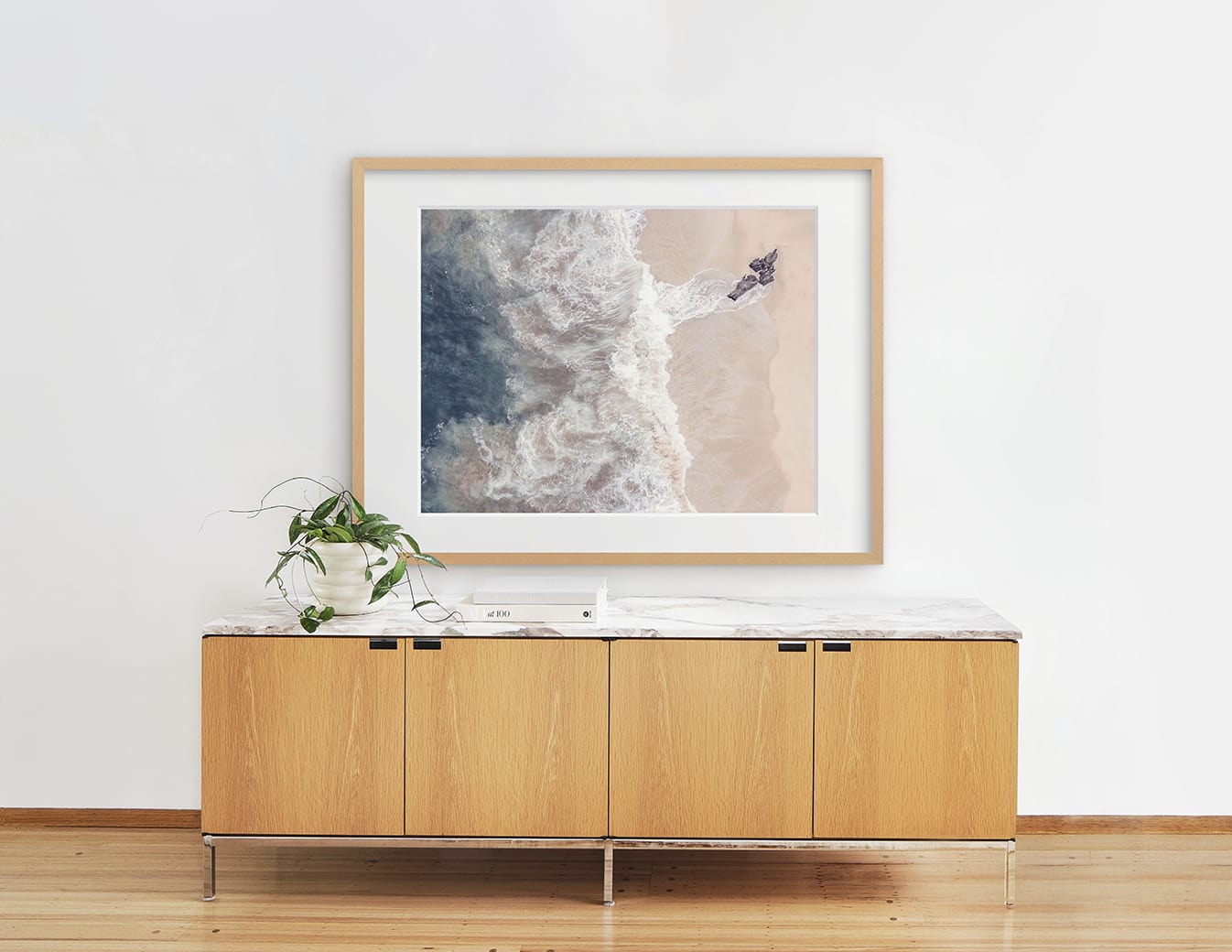
Before we get into the specifics of choosing the right print size, it is important to understand how fine art is measured. Fine art is often measured in width x height (which is different from how a TV is measured diagonally). When you shop for a framed fine art print, the dimension on the website includes the frame size. This makes it more practical for you when considering an art size according to your room size. Depending on the frame width profile and the matting/border style, the size of the print itself can be smaller.
If you’re looking to liven up a blank stretch of empty wall with art, our stylists recommend aiming to take up between 60%-75% of the wall space with the piece (or pieces) you select. A single large wall art nicely accentuates your room and immediately draws people’s attention. At Minted, most art prints are available up to about 48” x 70” (portrait) or 70” x 48” (landscape). For a smaller empty wall, such as one in an entryway, staircase landing, or awkward corner, one piece of art should be all you need to reach the 60%-75% rule. Pieces in portrait orientations often work best in these areas, as they can help accentuate the vertical height of a smaller space.
If you’re looking to fill a large empty wall, such as a hallway, you can also opt for multiple art prints, either as part of a diptych, triptych, or even a full gallery wall. You can explore our full guide to building a beautiful gallery wall to learn how to piece together art in multiple sizes and styles. You can also preview the art in your room through our augmented reality feature. Simply go to the design you like on your phone and tap on “View in My Room” link.

bloom in Ink by Tae Lee
When it comes to hanging art over furniture like beds, fireplaces, console tables, or couches, aim to have the piece take up two-thirds to three-fourths of the width of the furniture. Anything smaller than this can look unanchored in the space, while pieces that are wider than the furniture beneath them can throw your room off balance.
There are a few more things to keep in mind to get the sizing just right depending on what piece of furniture you plan to hang your art over.
Here are a few of our stylists’ top tips:
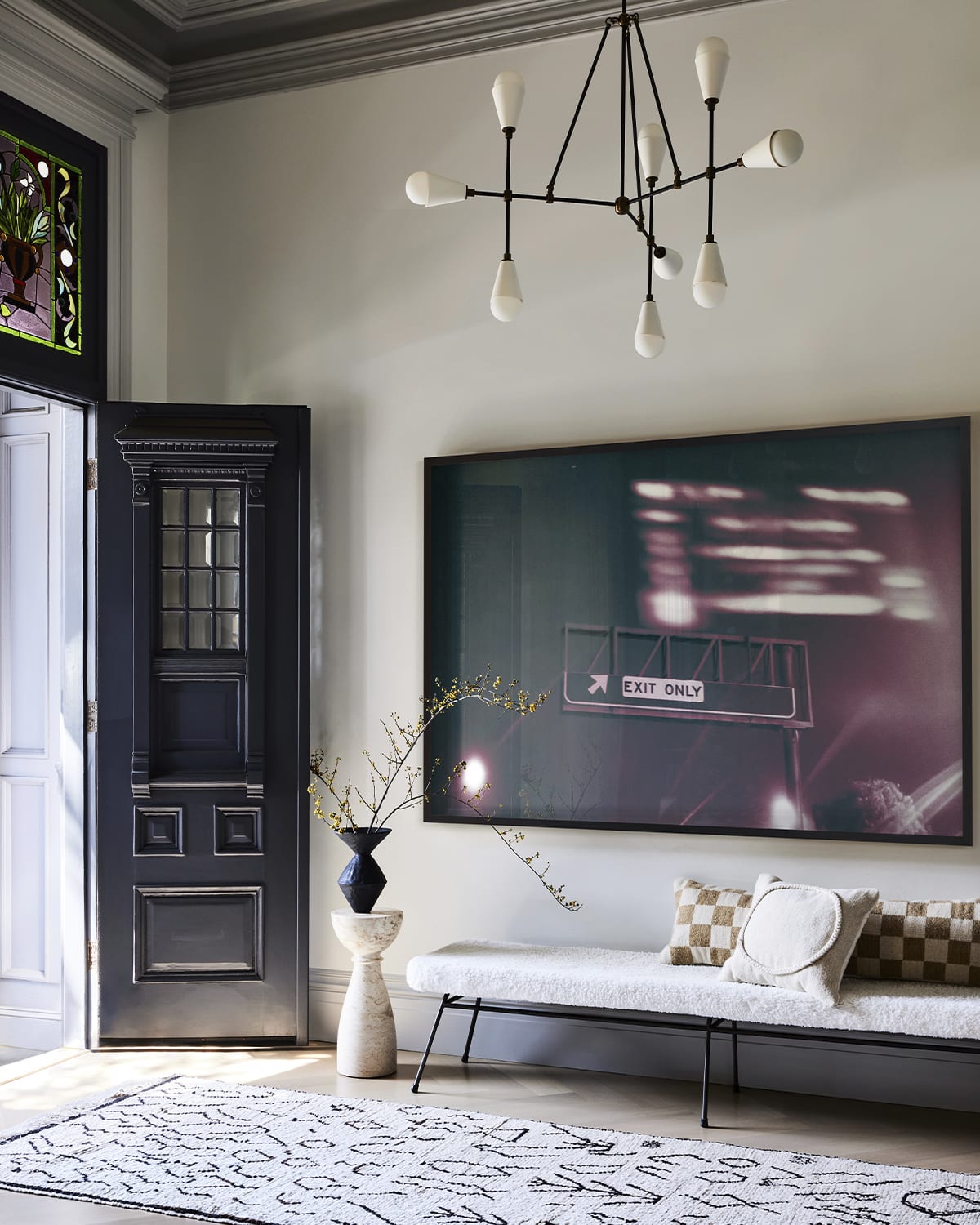
When hanging art, the best rule to follow is to center the print at eye level, which is typically 55”-60” above the ground. This rule of thumb is easy enough to apply when hanging art on empty walls, but it adds an interesting layer of complexity to the guidelines for hanging art above furniture that we discussed above.
Generally, when hanging art above furniture, you’ll want the piece to be large enough to be both anchored just above the piece of furniture and be centered with eye level. (Though this doesn’t necessarily apply for decorating above mantles, taller chests, or high headboards.) This means that when picking out a piece of art to hang above low-slung furniture like a couch, you’ll want to choose a piece that is both wide enough to look proportional with your furniture, and tall enough to take up the right amount of space on the wall above.

You Make Me Blush by Helen Makadia
There are no one-size-fits all recommendations when it comes to picking art based on the size of the room you’re looking to decorate, as large pieces can look as great in small spaces as they do in big ones. Instead of focusing solely on room size, think about what you’d like the focal point of the room to be and how you’d like people to feel when they’re in the space. For a modern, minimal feel, you could opt for just one large print to give the room a centerpoint. Or, if you’re looking to create an eclectic atmosphere, you could balance vintage and mismatched furniture with a smattering of smaller prints.
You’ll also want to consider the proportions of some of the room’s features. A space has large sliders, windows, or built-ins, you may want to opt for a larger piece of art to act as a balance, regardless of how big the room is.
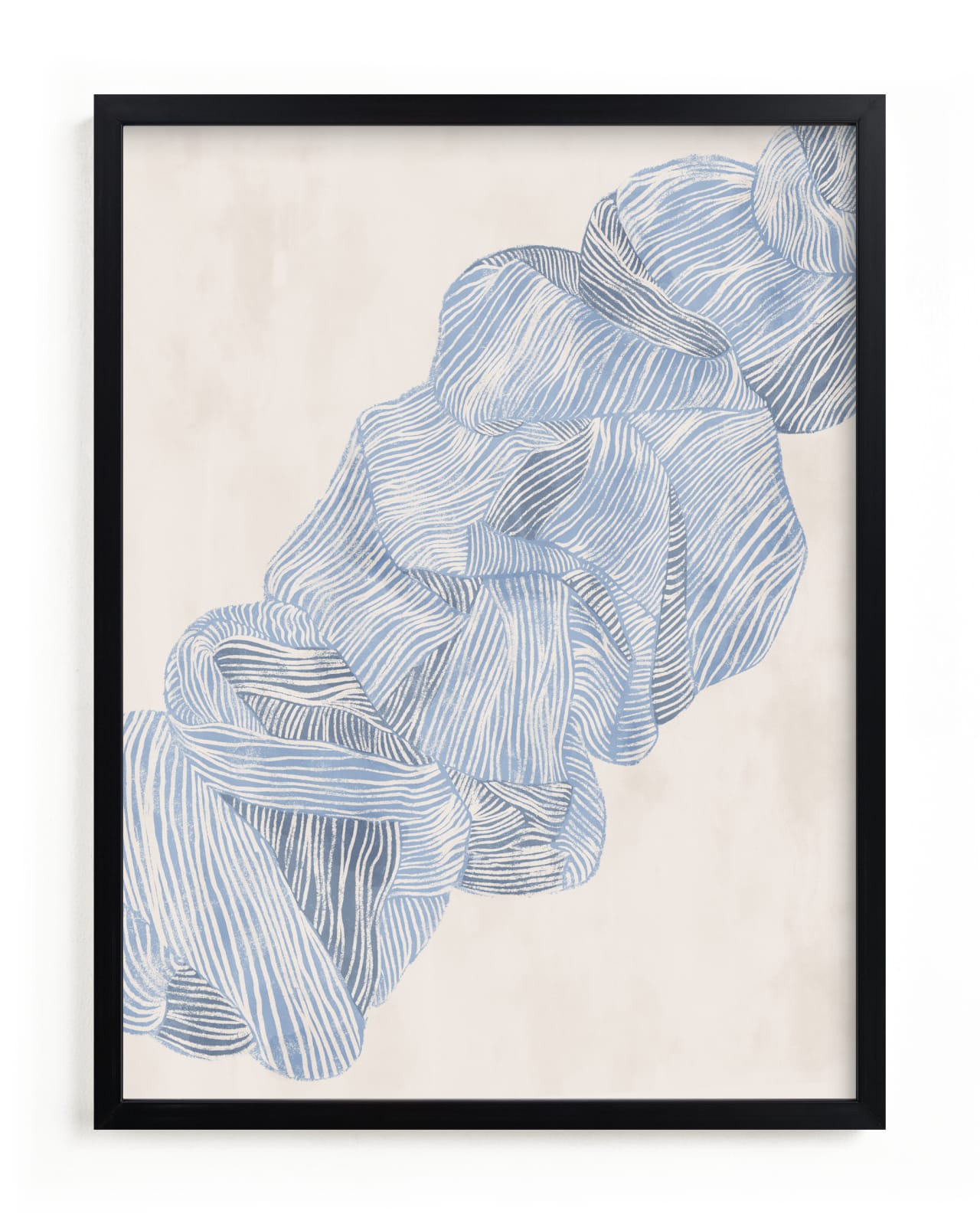
Groove by Pati Cascino for Minted
When considering what print size will look best in your space, you’ll want to take all of the elements of the wall into account. This includes furniture placed against the wall, lighting (including sconces and floor lamps), shelves, windows and window treatments, tall houseplants, etc. Once you have all of those elements mapped out, you can use the negative space to determine what size and which orientation your print or prints should be.
Keep in mind that the main goal here is to create a sense of balance between all of the existing elements in the room, which can be tricky! If you’re struggling to envision what a piece might look like, you can text a picture of your wall to Minted’s free art styling service. Your stylist will size the art, suggest framing and even provide you with a rendering of the final look in your space based on the photos you provide.

If one large-scale print doesn’t appeal to you, gallery walls are a great option for rooms of all sizes. There are tons of unique ways to arrange a gallery wall — ranging from perfectly symmetrical grids of photographs or prints in a similar theme to more eclectic mixes of sizes, orientations, and styles.
If you’re opting for the more eclectic route, start by choosing the piece of art you’d like to make the focal piece of the gallery wall. This doesn’t have to be the biggest piece in the bunch, but it will usually be centered at eye level along the width of the open space you’re decorating. Then create a mix of smaller personal prints and large art to add a level of detail that takes the viewer through a journey. You can also include maps, custom house portraits, and framed photo prints for further personalization.
To get a sense of how the layout will look best in your space, we suggest using the butcher paper or parchment paper trick. Before purchasing your desired artwork, cut out butcher paper in the various art sizes you are considering and tape them to your wall to get a good idea of what sizing looks the best. Experiment with different sizes and orientations, giving yourself the creative freedom to easily move pieces around until you find the design you think is most fitting. (This also works well to help visualize singular pieces of art in your space, and to correctly position nails on the wall when it comes time to hang your new art.)

Using a pair or set of prints can be a great way to create a large footprint of art on an expansive wall. This is a great option if the wall you’re looking to decorate is wider than it is taller, making it better suited for a landscape print. If you’re in love with a vertical (or portrait) print, think of pairing it with another vertically-oriented print in a similar style to cover more of the wall’s width.
You could also use art pairs to call attention to narrower walls flanking elements like fireplaces, doors, or windows by pairing a print on either side of the element.
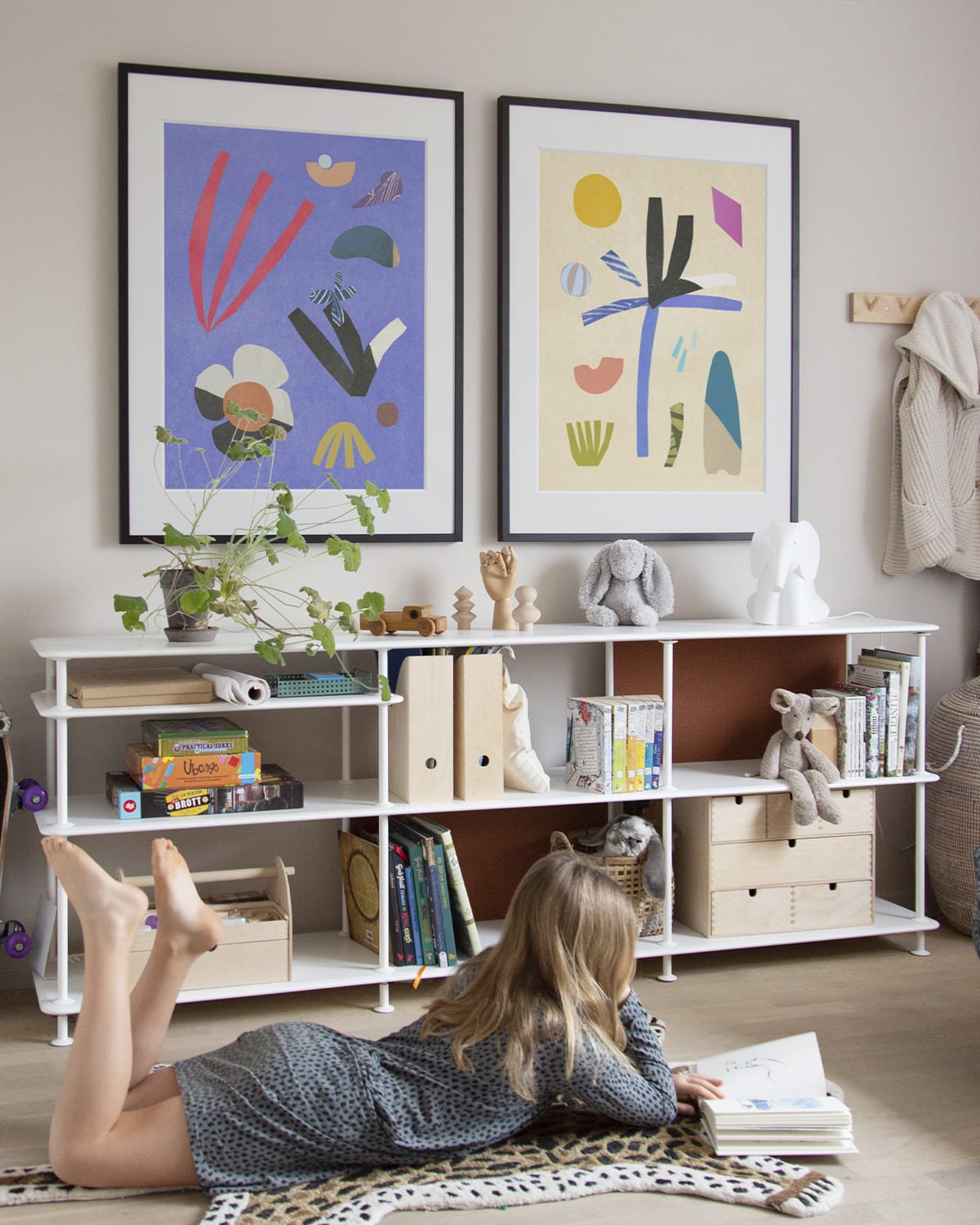
If you didn’t already know, portrait orientation means the artwork is taller than it is wide, and landscape orientation means the artwork is wider than it is tall. An easy way to remember this is that the Mona Lisa is a portrait that is portrait-oriented.
“When deciding between landscape or portrait prints, it’s generally advised to orient them according to the available wall space,” says Melanie, one of Minted’s Art Stylists who has helped thousands of Minted customers find the perfect artwork for their unique spaces.
Portrait-orientated wall decor can give height to a room or fill a space with narrow walls. It can also work well in a kitchen where wall space is limited or even up a staircase to fit a tall wall space. Landscape-oriented artwork, on the other hand, can make a room feel wider. Landscape prints tend to look great above a bed or couch.
“If you have a long wall with lots of furniture placed against it, you might decide a few portrait prints would be better suited than one large horizontal print because of the separation on the wall due to the furniture placement,” says Melanie.
Ultimately, the furniture in the room you’re looking to decorate may be the best clue as to what orientation will work best. If you’re struggling to decide what will look best, go with a square print to provide balance to a space.

It is important to keep in mind that adding a mat to a print will make the size of the art itself smaller. For large walls, going bigger on matting and opting for a chunky frame style can lend visual weight to a print, making it appear larger than it actually is in the space. Or, for a more minimal approach, you opt to float mount a print within a sleek frame, which again, will help the print cover more ground without looking heavy on the wall.
For the biggest impact, you could play with putting paintings or abstracted art on framed canvas prints. Photography also looks great on our modern acrylic mounts, putting the artwork front-and center. Keep in mind that these frame and mat options will change the overall look and feel of the art piece. For a more modern vibe, choose float mounting or aluminum-mounted art. For a more classic look, choose matted art.
To discover which format fits your personal style, we recommend playing around with our augmented reality tool, which allows you to use your phone to test what various prints, frames, and matting options will look best in your space.
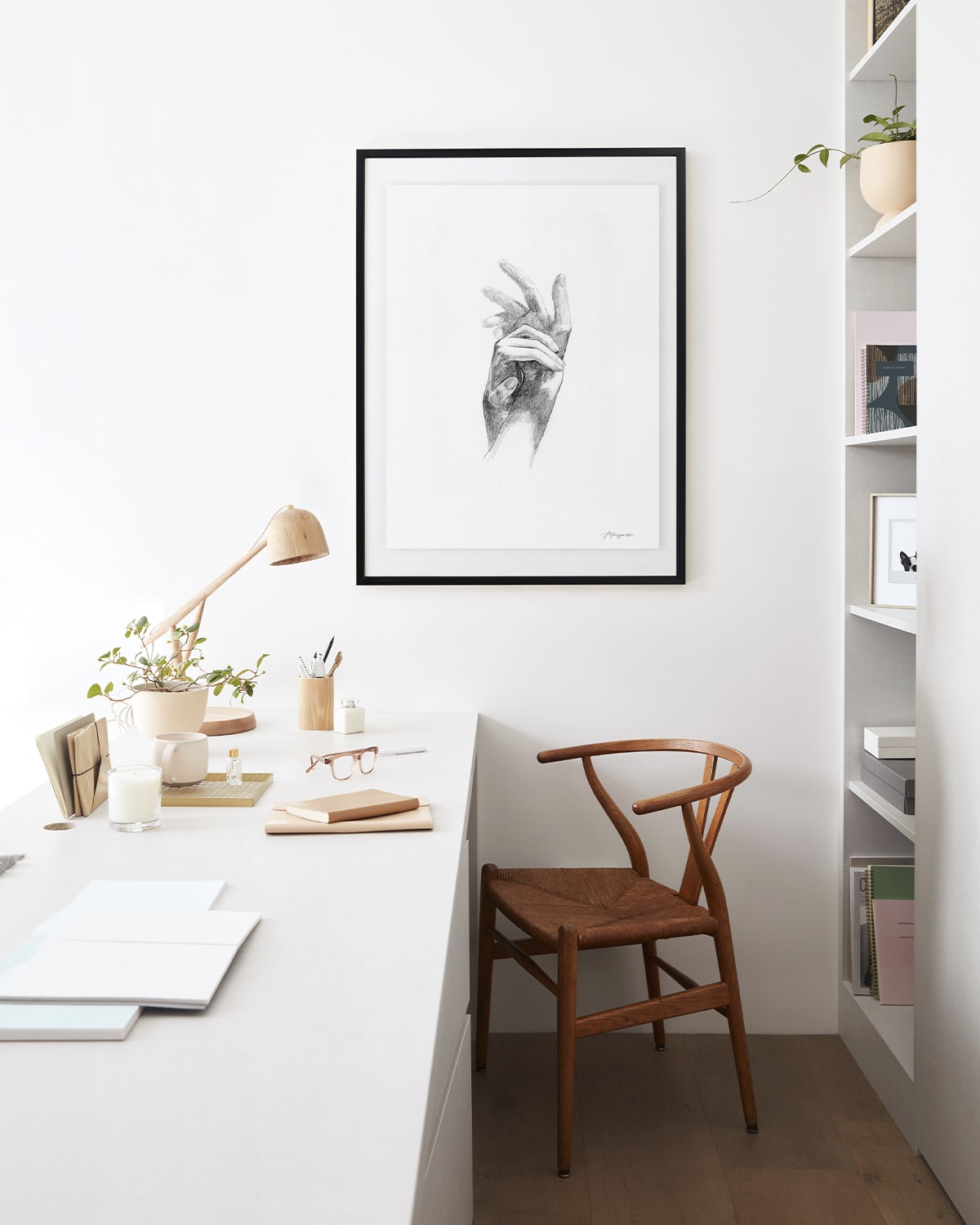
While all of these tips will help guide you to choosing the right piece for any space, there are a few tricky spaces where we often see our clients struggling to choose art for.
Here’s what to know:
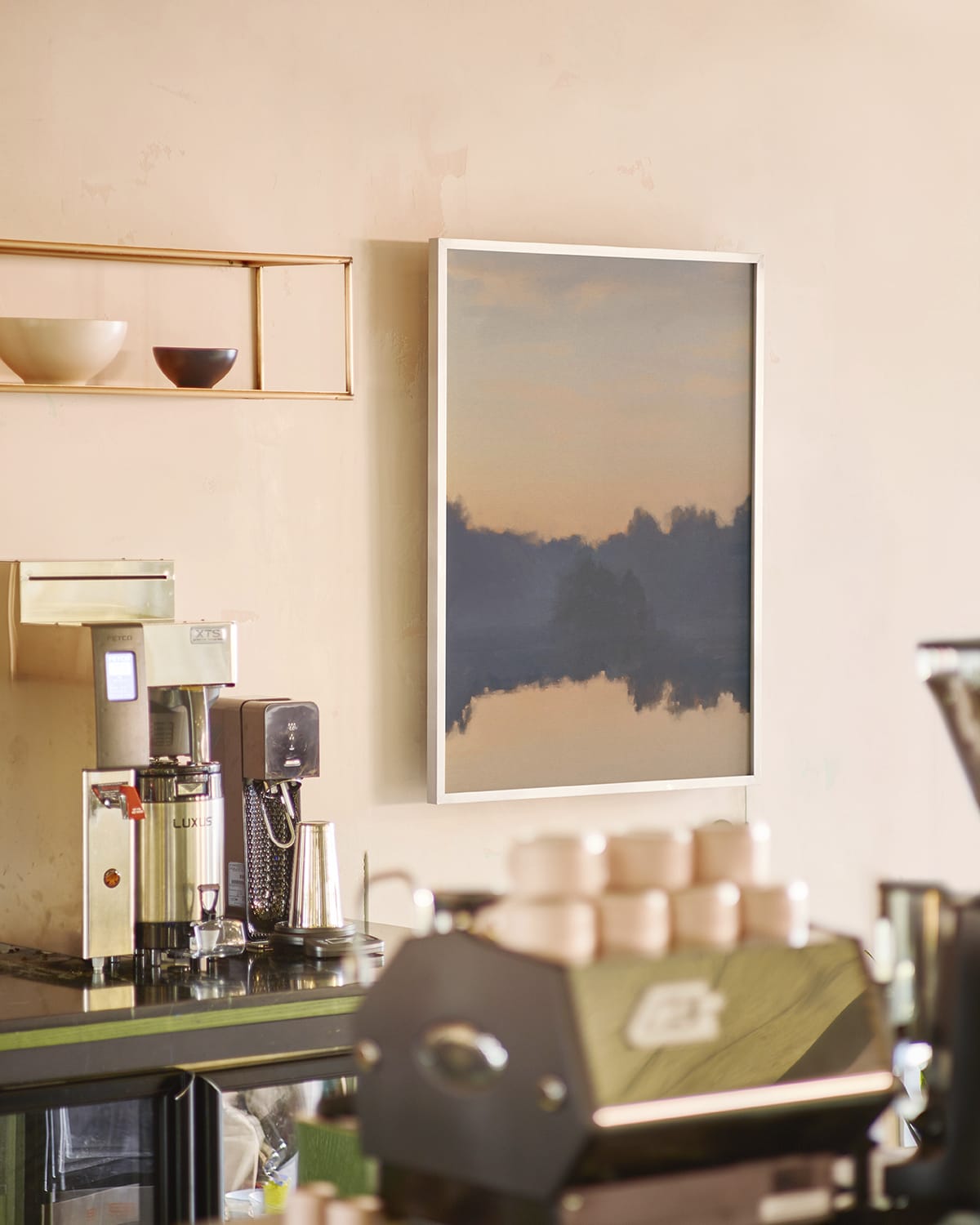
If you are decorating a large open room, you could go as big as will fit! The important thing to consider is the balance of your space. If your room is already packed with lots of furniture and decor — such as bookshelves, windows, doors, etc. — you might want to consider smaller pieces of art that leave some breathing room on the wall. Sometimes, creating a space for the eye to rest is just as powerful as a splashy decorative element.
To determine where to hang your large piece of art, start with the two rules of thumb that apply to hanging any print: 1) Where can you hang it at eye level? 2) Is the print taking up two thirds of the width of the wall or of the piece of furniture directly underneath it?
Answering those two questions will go a long way to helping you determine where a large piece of art may fit in your home. You’ll also want to consider where it is safe to hang a large art print, as they can be heavy. If you can, try to hang your print on a stud or using drywall anchors. For more tips on where to place large art in your home, take a look at our complete guide to large wall art and canvas prints.
You want to be able to see your beautiful new piece of art, so the general rule of thumb is to center the print at eye level (typically 55” - 60” from the ground). This same rule applies even if you’re hanging a piece of art in a room with double-height or very tall ceilings — you don’t want to strain your neck looking at the print.
The two-thirds rule is key here! Depending on the weight of your bed frame, look for landscape prints that are either 40” x 30” or 54” x 40” (note that the larger print will work nicely to balance out a chunkier or wider bed frame). If you’re opting to hang two portrait-oriented prints above the bed, aim to achieve the same width from the outside edge of the first frame to the outside edge of the second. This means looking for 18” x 24” or 24” x 30” prints.
When picking out prints to hang above a king size bed, look for landscape-oriented artwork in either 54” x 40” or 60” x 44”. Alternatively, you can opt to pair a set of smaller prints above your bed frame or even create a gallery wall to cover the space — again aiming for whatever you hang to be at least 54” wide from the outside edge of the first frame to the outside edge of the final frame.
When it comes to filling your home with art, let your personal style and the feeling you want to create in your space lead the way. If you prefer more modern interiors, you’ll want to take a highly-edited approach to hanging art to keep breathing room in your space. Start by thinking about the focal point of your room, and then choosing to accent that space with a large print or a few well-placed smaller pieces of art.
If your style is more eclectic or vintage, then you can be more liberal with how many walls you decorate. In addition to hanging prints that speak to you, you could also choose to use a mural to accentuate one wall with art, and then layer prints on top of that.
To get a sense of what will work best in your space, play with Minted’s augmented reality tool, which projects the print onto your wall!
Our stylists love the look of elevating large art prints with high quality and sleek frames. If you’ve fallen in love with a large oil or watercolor painting, go for our framed canvas option to give the art an original feel. For photography and modern art, try our aluminum-mounted acrylic option to lean into the bold energy of the piece. And finally, to give your space a modern gallery feel, try float-mounting your print within a minimal frame.
When hanging multiple prints together, we suggest leaving about 3” between art prints to give each piece its own room to really shine. To test the layout of a gallery wall or set of art prints, use the butcher paper technique. Start by cutting out pieces of butcher paper in the various sizes you are considering and tape them to your wall to get a good idea of what looks best. Experiment with different sizes and orientations to see what you like, giving yourself the creative freedom to easily move pieces around until you find the design that feels good.
This technique also works well if you are stuck trying to decide between a slightly smaller or slightly larger size of a singular print!
